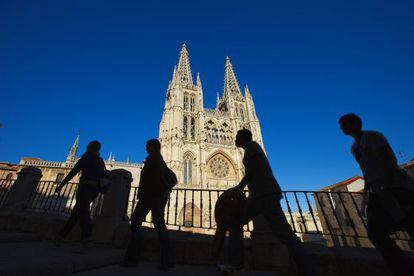Trampling the holy path
Italian writer says Santiago pilgrimage route needs protection from mass tourism

“The Camino de Santiago is not a trekking route and its essence needs to be maintained so it is not cheapened,” said Carmen Pugliese earlier this month before being awarded the first Aymerich Picaud Award for journalism, given by the eight historical regions — Aragon, Navarre, La Rioja, Burgos, Palencia, León, Lugo and Santiago de Compostela — that formed the League of Journalists for the Camino de Santiago.
Declared a European Cultural Route by the Council of Europe in 1987, the pilgrimage trail that stretches across northern Spain, with some starting points in France, has in the last two decades changed from a spiritual journey undertaken by a few hundred people a year to a well-beaten path trod by hundreds of thousands: a “massive increase that is never completely positive,” given its religious significance, said Pugliese, a Milan native who relocated to A Coruña and has lived in various places on the Camino route. Last year 215,800 people from 156 countries completed the Camino de Santiago, or at least that is the number recorded by the Catholic Church as having traveled 100 kilometers or more on foot or horseback to qualify for “La Compostela,” a certificate issued by the ecclesiastical authorities. If a pilgrim travels by bicycle, 200km is the requirement.
“This is not a trekking route and its essence must be maintained so it does not become devalued,” noted Pugliese. The end point of the Camino is the Cathedral in Santiago de Compostela, where the remains of Saint James, one of the Apostles of Jesus Christ, are said to lie.
In 1991, when she walked the route for the first time, “there were hardly any other people,” Pugliese recalled. She has suggested altering the criteria to qualify for a “Compostela.” In 1993 the then archbishop of Santiago de Compostela, Antonio María Rouco Varela, said that in the Jubilee Year of 1983 some two million people swarmed the route “and pushed and shoved in the communion.”
This is not a trekking route and its essence must be maintained"
Pugliese stated the need to maintain the “magnet of fascination” the Camino holds as a means of reflection and “solitude,” and where people from different cultures can be brought together. The key, the writer believes, would be to separate these from people traveling for other reasons. She notes that in recent years there has been a spate of books and films — and celebrity walkers — that have popularized the Camino. Traditionally frequented by Europeans, it is now common to encounter Americans, Japanese, Koreans and many other nationalities en route.
On being asked about a curious study conducted by psychiatrist Jesús de la Gándara over seven years on 38 pilgrims admitted to hospital in Burgos with severe psychological disorders, Pugliese said that “the Camino de Santiago is a moving mental asylum.” She then added: “Much like life itself.”
Pugliese said she feels “honored, surprised and very happy” to receive the Aymerich Picaud award, which is named after the 12th century monk to whom the Codex Calixtinus is attributed. The priceless manuscript is considered the world’s first tour guide book, and contains sermons, reports of miracles and advice to travelers on the Camino de Santiago. “Even though it wasn’t him that wrote it, it doesn’t matter, it’s symbolic,” says Pugliese of the tome that disappeared in 2012 only to turn up in the home of a disgruntled former cathedral employee.










































